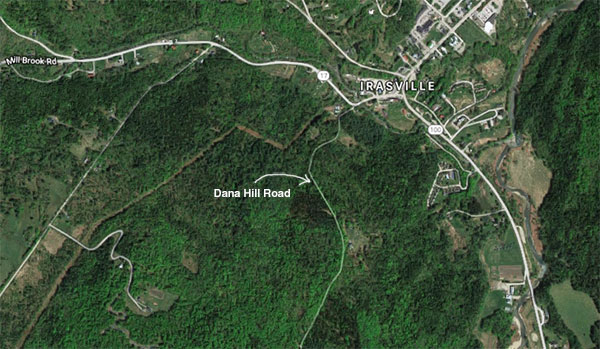The Waitsfield Select Board will begin the process of seeking grants to fix Dana Hill Road in advance of the board deciding whether or not to reclassify the road from Class 4 to a legal trail. That process is contingent on the town being given an extension of a year to complete the work.
The board, at a July 23 meeting, formally began the process of considering whether to reclassify the road and heard from a roomful of road residents opposed to the idea. Vermont’s Clean Water Act requires that towns obtain a municipal general road permit which requires that certain road standards be met. For Class 4 Dana Hill Road those standards require that two specific areas of gullying be addressed. The town’s responsibilities also include stream crossings and culverts.
Since the Clean Water Act passed, Waitsfield has been reviewing its existing Class 4 roads and the board initially proposed downgrading the road to a trail due to the potential cost of upgrading the road.
Board member Kari Dolan explained that the point of the municipal general road permit is to reduce erosion to improve water quality while increasing the resilience of the road. Dolan also explained the federal grant – administered by the Central Vermont Regional Planning Commission – that is aimed at developing case studies of how towns are handling Class 4 road issues. There is also state funding available for towns to bring roads into compliance with the requirements of the permit. The town had already applied for that funding for the coming year.
GRANT FUNDING
Board member Sal Spinosa asked Dolan if the town would qualify for the grant funding if the road is reclassified as a trail. Dolan said reclassifying it would disqualify the town from state or federal funding for the road.
Madhurii Barefoot, owner of True North Wilderness, which has permits to operate on a 25-acre parcel of land on Dana Hill and in the Howe Block of Camel’s Hump State Forest, voiced strong opposition to downgrading the road, noting that her wilderness therapy program requires her to have medical access for participants.
She said that she and other road residents regularly do their part to maintain the road, removing fallen trees to keep the road open for travel.
Board chair Paul Hartshorn told the group that with other Class 4 roads, the town had partnered with residents of those roads to improve them and said that those residents who had contributed to fixing their own roads would object if the town paid for upgrading Dana Hill Road.
NOT DEGRADE FURTHER
“Nobody is asking for an upgrade. We’re asking that it not degrade further. The town used to do some maintenance on that road. I hope we can go back to the way it was 10 years ago. The road was passable and usable for all, said road resident Peter Laskowski.
True North attorney Jeff Hand pointed out that there are much more stringent regulations for Class 3 roads and said that the town has to maintain the section of Class 3 road at the bottom of Dana Hill.
“If you don’t maintain town control over the Class 4 section, you’re likely inviting more expense and damage to the Class 3 section. It’s to the town’s advantage to maintain the status quo so that you’re not buying yourself a bigger problem,” Hand said.
"Whatever is coming off the Class 4 road is ending up on the Class 3 road. If you change this to a trail the town has much less control over what happens,” he continued.
Laskowski raised the issue of lost tax revenues if the town were to downgrade the road, noting that there is more value for a home that is accessible via a town road than one accessible via a legal trail.
“A house on a trail is not worth the same as a house on a town road, maybe half as valuable or less. If that happened, we’d all grieve our taxes. You can’t get propane delivered and can’t get your septic pumped. You’re isolated,” added Blaine Laskowski, a former lister for the town.
WORKING COOPERATIVELY
“I see benefits to working cooperatively with you on this,” Dolan said, noting that seeking grant funding and collaborating on the local match share with property owners will allow the important recreational uses to continue on Dana Hill as well as provide access for property owners.
“I think we can come up with 20 percent of $15,000 to do this work,” Dolan said.
Road resident Russ Chalom suggested that the town come up with a five-year plan to put between $10,000 and $20,000 into the road to get it back to the shape it used to be in before the town stopped performing maintenance on it.
“I haven’t talked to anybody about this, but I think there’s some concern about why we’d spend so much money on that road. We need to keep that issue in mind,” Spinosa said.
“The idea of spending so much money on the road is a fable. It’s folklore. There’s been nothing spent on the road and we’re paying the town $100,000 a year collectively in taxes. We’re happy to contribute, but we want something back,” Laskowski said.
Board member Jon Jamieson took issue with Laskowski’s math and pointed out that some 80 percent of that aggregated tax total was going to education taxes versus town coffers.
MAKES SENSE ECONOMICALLY
"My point is that the town does have resources and the costs are not as great as initially thought. What we want is to have what we had before. In the long run, it’s cheaper to keep the road as Class 4 and do maintenance on it than it is to give it up and have unfortunate events occur later on. Economically it makes more sense,” Laskowski added.
Hand urged the board to take the path of collaboration and said that sooner versus later would be better. He said that to make the determination that downgrading the road to a trail requires showing that it advances the public good.
“The only justification so far is cost. At a minimum downgrading the road requires more investigation into the impact on public safety, property values and the impact on water quality. There could be a real perception that the town is reclassifying the road only to avoid its obligation to water quality. That’s a terrible precedent to set to set,” Hand said.
The board will revisit the issue on August 13.







